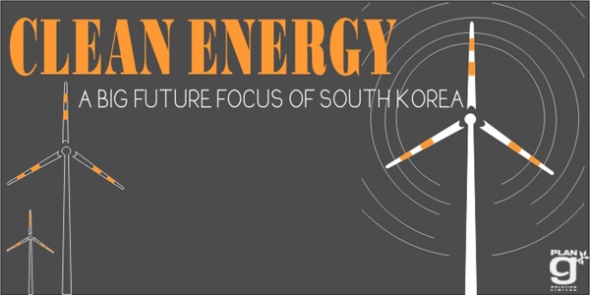By Andrew Ju
Nuclear energy and green technology (solar, wind, hydro) are among the most exciting technologies today that, if perfected, could revolutionize the world and hail a major landmark for human progress. This tantalizing possibility is, of course, a devilishly difficult and arduous task that has thwarted most efforts thus far. South Korea, however, has nonetheless boldly strayed from the path of older, fossil-fuel based energy sources and is doggedly pursuing the dream of abundant, cheap, clean energy. My Fulbright research topic and blog posts focus on the political economy of the nuclear and green technology industries in South Korea; or in layman’s terms, how the government and these industries interact and influence each other as they strive towards this collective goal. This initial blog post will be an overview of the scope of my research and a chance to start a dialogue that I hope will engage and inform.
So why am I interested in nuclear and green technology in South Korea (and why should you be too)? Ignoring the glimmer of a future energy revolution, the challenging realities of these two industries and related government policies are about finding an answer to two crucial problems. The first is the very basic and critical challenge commonly known as energy security, or how to acquire and generate enough energy in a country to keep the lights on and the machines running without going bankrupt. The second is the dilemma of maintaining a healthy growing economy and at the same time preserving the environment. These two problems are not unique to Korea, but Korea’s attempts to solve them have been distinct. South Korea is in many ways at the frontier of solving these two problems – partly because with such few natural resources and high demands from its intensive economy, it has no option but to innovate and risk, but also because its extraordinarily concerned citizens and remarkable democratic dialogues, nimble government policies, and forward-looking tech industries have all culminated in innovation. Only Korea and a handful of other countries are truly experimenting with answers to these two problems today, and much of the world is watching closely to see which of these pioneered paths are viable for the future.
In addition to these very broad issues of energy security and environmentally sustainable economic development (or “Green Growth” as South Korea labels it), the nuclear energy and green tech industries are a useful lens through which to examine South Korea’s economy, foreign policy and relations, and even its democratic traditions and social justice discourses. Some examples to be discussed more thoroughly in future posts are:
– How the nuclear energy and green tech industries exemplify the decades-old dichotomy between the dominant chaebols and the marginalized small-medium enterprises (SMEs) that characterize South Korea’s economy. Indeed, the use of nuclear and green tech industries as a case study is fascinating as the chaebol titans are epitomized by the heavily government-supported, nontransparent nuclear energy industries, and yet the scrappy small-medium enterprises have never seen a more promising champion than the green tech industry.
– The regional economic inequalities in Korea, with wealth focused primarily in Seoul or in coastal areas, and how the nuclear and green tech industries are affecting these balances. The deliberate placements of nuclear reactors and the fostering of green tech companies in specific regions are resulting in new developments in the economic geography of Korea.
– Korea’s use of these technologies and industries internationally, whether it is exporting for profit, such as in 2009 when it exported four nuclear reactors to the UAE for $20 billion, or for shaping its international image and strengthening ties with strategic countries through organizations such as the Global Green Growth Institute (GGGI).
– The democratic dialogues that occur between the government and local communities as the country wrestles with where to place nuclear reactors and fluctuating public opinion. These kinds of exchanges have only intensified since the Fukushima Daiichi accident in Japan in 2011 and are a glimpse into the struggle between large government economic interests and local community interests that have been a mainstay of Korean democracy and politics.
I’ll end this post by addressing two questions I am invariably asked when discussing my research: “So are you for nuclear or against it?” and “Which side are you on?” The ubiquitous question underscores just how divisive of a topic this is, and my honest answer is that I’m not sure. This is a complicated situation with many characters, conflicting interests, advantages and disadvantages to all possible outcomes – and I’m simply happy to be in the middle of the exchange, learning what I can. I’ve had the privilege of hearing thoughtful and valid arguments on both sides of this politically controversial debate (which will be deliberated upon in future posts), but these blog posts will not be a presentation of any personal agenda or policy view. Instead, these posts will simply narrate an honest search for answers and new questions, with all the complexities and frustrating aberrations included. I hope I’ve piqued enough interest with this first post that some of you will join me in this journey.
References
Berg, Su-Hyun, and Robert Hassink. “Emerging Green Clusters in South Korea? The Case of the Wind Power Cluster in Jeonbuk Province.” STI Policy Review. no. 1 (2012): 63-79. http://www.wigeo.uni-kiel.de/emerging-green-clusters-in-south-korea-the-case-of-the-wind-power-cluster-in-jeonbuk-province.pdf (accessed January 17, 2014).
Chung, Jae-Young, and Richard J. Kirby. The Political Economy of Development and Environment in South Korea. London: Routledge, 2002.
Kosch O’Donnell , Jill. “ROK Green Growth: Looking Back on Three Years.” Council on Foreign Relations Press. . http://www.cfr.org/south-korea/rok-green-growth-quarterly-update/p26445 (accessed January 17, 2014).
Reuters, . “South Korea cuts reliance on nuclear power, but new plants likely.” The Economic Times, 01 14, 2014. http://economictimes.indiatimes.com/news/international/world-news/south-korea-cuts-future-reliance-on-nuclear-power-but-new-plants-likely/articleshow/28775739.cms (accessed January 17, 2014).

